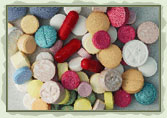
What is Ecstasy?
Ecstasy is a synthetic and psychoactive drug that can cause an increase in energy and/or hallucinations in users. The scientific name for Ecstasy is MDMA or 3,4 methylenedioxymethamphetamine. Other common names for Ecstasy include E, XTC, X, Adam, love drug, hug, beans, clarity, lover’s speed and Euphoria.

Ecstasy is usually taken by swallowing a pill, tablet or capsule. These come in a variety of shapes, sizes and colours. They often display a stamp or logo. Ecstasy can also be snorted (by crushing tablets into powder form), smoked or injected intravenously.
More Than Just Ecstasy: What Else Is In There?

Ecstasy isn’t always what you think it is and even if it is what you thought, it's impossible to know what to expect!
Ecstasy was originally made of a single specific chemical (MDMA). In order to avoid legal problems, chemists working in secret labs started creating new drugs with similar characteristics (and sometimes similar effects). Today, Ecstasy may or may not contain MDMA. "Ecstasy commonly comes in brightly coloured pills with common logos that youth easily identify," as indicated by Health Canada’s Drug Analysis Service. "The logos are meaningless when it comes to identifying what may be in the pills. There is very little correlation between type of logo or colour of tablets and its contents." The lesson is: don’t be fooled by the colour or the pattern on the tablet. A snazzy imprint doesn’t guarantee quality or purity since it can be used on many different substances. Testing done by Health Canada (2004) revealed that tablets containing at least 22 different substances or combinations of substances were found in samples thought to be Ecstasy.
What Are the Effects?
Ecstasy can cause various effects on the human body. Without naming them all here, stimulant effects are most often experienced whereas hallucinogenic effects, those that cause hallucinations, are felt to a lesser extent and usually occur with higher amounts.
When initially taken, Ecstasy causes minor stress, higher blood pressure and heart rate, tightened jaw muscles, moist skin and dry mouth. Happiness, relaxation, higher self-confidence and energy and lower inhibitions then follow. Senses and communications are enhanced. In quiet settings and at low to moderate doses, ecstasy can produce feelings of pleasure (for example, users can feel free, understood and accepted by others).
Once the pleasant phase is over, users feel tired, sad, depressed and cranky. Panic attacks and nightmares may occur.
Frequent users may start experiencing a number of problems. They may feel dehydrated, weak, moody and mean. Tolerance to Ecstasy develops quickly, which means more of the substance is needed to get the same effect. Some users may become psychologically dependent on Ecstasy, which means they are preoccupied with the need to take more. It is not known if physical dependence can result from the use of Ecstasy.
Find out more on the effects of Ecstasy in the following articles:
How Long Do the Effects Last?
The effects of a single hit of Ecstasy can last from 3 to 6 hours. Users feel the effects within one hour. Unless the user takes more of the drug, a process called "bumping", he/she will then experience a low. After-effects may last for days or weeks.
Is It Dangerous?
Ecstasy is dangerous. It can lead to dehydration and hyperthermia, especially when a person is very active, for example, when dancing.
A user can experience unwanted effects when knowingly or unknowingly mixing Ecstasy with other substances, including prescription medications, methamphetamine, cocaine, ketamine, marijuana, PCP, dextromethorphan, psilocybin mushrooms, LSD, GHB and alcohol.
Ecstasy use can also lead to increased or abnormal heart rate, high blood pressure and other related problems, especially for those who are at-risk of developing these problems.
There is an increased risk for individuals who use Ecstasy, if they have asthma, epilepsy, diabetes, constant fatigue or heart, kidney or psychological problems.
Where Does It Come From?
Ecstasy was first created by a pharmaceutical company in 1912. Over the years, it was used for military and psychotherapy purposes. In the late 1980s, it became a recreational drug with the beginning of the rave scene in Canada. Raves are dance parties revolving around techno music and usually taking place in unusual settings (such as open fields and abandoned buildings). More recently, the use of Ecstasy has expanded to other locations, such as bars and nightclubs. While most Canadians do not use Ecstasy, according to the  Canadian Addiction Survey (2004), 4.1% of Canadians aged 15 and older used Ecstasy at least once in their lifetime.
Canadian Addiction Survey (2004), 4.1% of Canadians aged 15 and older used Ecstasy at least once in their lifetime.
For more information, read the article from the Canadian Health Network and find out more on,  How does the drug Ecstasy affect health?
How does the drug Ecstasy affect health?
Definitions:
|
Dehydration: | Fluid loss |
|
Drug Analysis Service: | This Health Canada Programme analyses suspected illegal drugs that are seized by enforcement and customs services. The Programme is also involved in the investigation and dismantling of clandestine laboratories that make illegal drugs. |
|
Hyperthermia: | Also known as heat stroke, is an acute condition which occurs when the body produces or absorbs more heat than it can eliminate |
|
Physical dependence: | The body becomes used to the drug |
|
Psychoactive drug: | A chemical that alters brain function, followed by temporary changes in perception, mood, consciousness or behaviour. |
|
Synthetic: | Produced by mixing different substances together |


